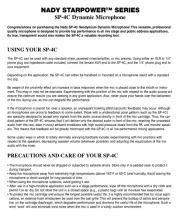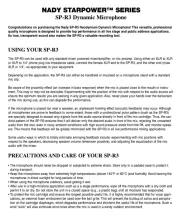Marantz M4U Manual
| Mærke: | Marantz |
| Kategori: | Mikrofon |
| Model: | M4U |
| Type: | Bordmikrofon |
| Tænd-/slukkontakt: | Ja |
| Højde: | 185 mm |
| Produktfarve: | Sort |
| Kabler inkluderet: | USB |
| Impedens: | 150 ohm (Ω) |
| Forbindelsesteknologi: | Ledningsført |
| Strømkilde: | USB |
| Diameter: | 48 mm |
| Enhedsgrænseflade: | USB |
| Desktop beslag: | Ja |
| Mikrofon frekvens: | 70 - 16000 Hz |
| Mikrofonretningstype: | Kardioid |
| Udgang til hovedtelefoner: | Ja |
| USB-stik type: | USB Type-A |
| Mikrofon sensitivitet: | -38 dB |
| Mikrofon vægt: | 252 g |
| Antal produkter inkluderet: | 1 stk |
| Mikrofon total harmonisk forvrængning (THD): | 1 % |
| Mikrofon, signal-til-støjforhold: | 76 dB |
| Maksimalt lydtrykniveau (1kHz): | 136 dB |
| Anbefalet belastningsimpedans: | 1000 ohm (Ω) |
| Selvstøj: | 18 dB |
Har du brug for hjælp?
Hvis du har brug for hjælp til Marantz M4U stil et spørgsmål nedenfor, og andre brugere vil svare dig
Mikrofon Marantz Manualer

30 Juli 2024

21 Juli 2024

5 Maj 2024

1 Maj 2024

29 November 2023

17 Oktober 2022

16 Oktober 2022
Mikrofon Manualer
- Audio-Technica
- Audix
- Easyrig
- Manhattan
- Crestron
- Rode
- Airwave Technologies
- Phonak
- MayBesta
- Joby
- Polsen
- Bigben
- Sonifex
- EVO
- Singing Machine
Nyeste Mikrofon Manualer

5 November 2025

4 November 2025

4 November 2025

4 November 2025

4 November 2025

4 November 2025

3 November 2025

3 November 2025

3 November 2025

3 November 2025
